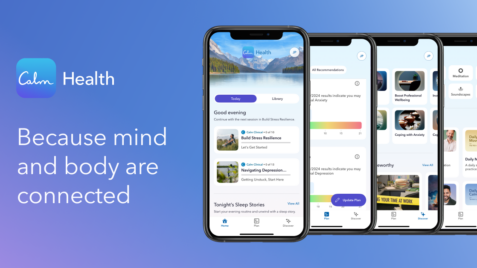Summary: As the prevalence of cardiovascular disease (CVD) continues to rise, employers are looking for ways to better support employees and combat spiraling healthcare costs. The connection between the heart and the mind demonstrates the importance of expanding CVD strategies to include mental health support, including specialized, evidence-based digital mental health support for people with heart disease and related conditions.
The cost burden of cardiovascular disease on employers is huge and expected to get worse
The cost burden of CVD on employers is enormous and expected to get worse. According to the Business Group on Health, 40% of large employers say that cardiovascular conditions are their number three cost driver today, just behind cancer and musculoskeletal conditions.
Of course, direct medical costs aren’t the only source of employers’ CVD cost burden. For US employees with high cardiovascular risk, cardiovascular events and related procedures are associated with significant indirect costs due to lost productivity, including workplace absenteeism and short-term disability.
Without policy changes or efforts to prevent CVD, both direct and indirect CVD costs will continue to grow, increasing the employer burden. Between 2010 and 2030, the real, total, direct medical costs of hypertension, coronary heart disease, heart failure, stroke, and all other CVD are projected to triple, from $273 billion to $818 billion. Indirect costs due to lost productivity related to CVD are expected to increase 61%, from $170 billion in 2010 to $276 billion in 2030.
CVD prevalence is high, and Black people are disproportionately affected
The cost trajectory isn’t surprising when you consider the prevalence of CVD: By 2030, 40.5% of the US population is projected to have some form of CVD. Cardiovascular disease is the number one killer of women, causing 33% of deaths each year, and the number one killer of new mothers. Alarmingly, almost half of women ages 20+ are living with some form of cardiovascular disease.
What’s more, health disparities and inequities exacerbate the risks of CVD, with CVD-related conditions disproportionately affecting people who are Black. Here are some examples:
- Hypertension—a major risk factor for heart failure, coronary artery disease, stroke, and other types of CVD—affects 56% of non-Hispanic Black adults in the US, more than non-Hispanic Asian adults (46%), non-Hispanic adults (48%), and Hispanic adults (39%).
- Black women are at highest risk for stress-related conditions such as hypertension, followed by Black men.
- Rates of hypertensive disorders of pregnancy are increasing, with Black women having the highest risk.
Recommended actions for employers to address hypertension and CVD risk
To address the hypertension risk, the National Alliance of Healthcare Purchaser Coalitions recommends the following action steps for employers:
- Know your data. Assess the prevalence, healthcare, and productivity costs of hypertension in your employee population. You can use the Alliance’s Claims Analysis Guide and Budget Impact Model to help.
- Make sure your plan covers certified home blood pressure monitors for employees diagnosed with hypertension.
- Conduct blood pressure screenings for employees at health-related and other work events.
- Partner with vendors that can address hypertension and help measure outcomes.
- Educate your workforce on preventative care for hypertension, CVD, and other chronic conditions.
Traditionally, preventative care for hypertension and CVD has focused on physical health behaviors, such as reducing salt intake, exercising regularly, maintaining a healthy weight, limiting alcohol consumption, and avoiding tobacco products. But research shows that mental health plays an important role in heart health, suggesting that many efforts to prevent CVD are incomplete.
The mind affects the heart, and the heart affects the mind
Indeed, the heart and the head have a complex, multifaceted relationship. Research has revealed these facts:
- A person experiencing persistent stress, anxiety, depression, or post-traumatic stress disorder (PTSD) may also experience physiological effects in the body, such as high blood pressure, increased heart rate, and reduced blood flow to the heart. These effects can lead to calcium buildup in the arteries, metabolic disease, and heart disease.
- At the same time, anxiety, depression and other mental health challenges may increase a person’s likelihood of adopting unhealthy behaviors, such as smoking or failing to take prescribed medications, which can also increase their risk of heart disease.
- What’s more, a cardiac event such as a heart failure, stroke or heart attack can cause fear, pain, and other responses that can bring on mental health disorders, such as depression, anxiety, and PTSD.
Employees facing workplace discrimination are at higher risk of hypertension and heart conditions
A study about US workers in the Journal of American Heart Association showed that a person who reported high levels of discrimination against at work has a higher risk of developing hypertension than employees who reported low levels of discrimination. The study defined “workplace discrimination” as unfair conditions or unpleasant treatment due to race, sex, or age. Participants who reported high workplace discrimination exposure were 54% more likely to report high blood pressure later.
Steps employers can take to incorporate mental health into their CVD strategies
It follows that employers aiming to address CVD and control healthcare costs have an opportunity to incorporate a strong focus on employee mental health in their strategies. In addition to smoking-cessation programs, nutritious food options, and coverage for home monitoring and medications, employers can implement a variety of measures to promote workforce mental well-being. Here are some steps employers can take:
- Recommit to establishing fair and inclusive workplaces using antidiscrimination policies and interventions.
- Offer flexible work hours.
- Help employees establish healthy work–life boundaries.
- Foster an environment that values taking mental health breaks.
- Offer mindfulness and mental health resources to support employees with stress, anxiety, depression, and other concerns, and to help them build resilience.
Specialized evidence-based support for employees with heart disease
Beyond these measures, employers can offer specialized, evidence-based, digital mental health support to employees and their family members who have heart disease.
Living with Heart Disease: A Guide for How to Thrive is an evidence-based program in the Calm Health app that helps to support users with depression and anxiety, unwind from stress, and feel empowered to navigate the challenges of life with heart disease.
Developed by licensed clinical psychologist Dr. Alise Conner, the eleven-session program uses techniques drawn from cognitive behavioral therapy and acceptance and commitment therapy approaches. Listeners are taught techniques to relax quickly and shape their feelings, thoughts, and behaviors, to support the individual’s mental and physical health.
The tools offered in the program may be relevant to other heart conditions, including the larger family of CVD, such as stroke, heart failure, valve disease, and heart rhythm disorders, and can be accessed immediately.
A strategic approach to employee mental health and well-being
Nearly 80% of large employers (79%) are making mental health access a top priority in 2025, according to the Business Group on Health. They’re working to expand employee access to virtual and onsite counseling and eliminate out-of-network barriers to care.
But employers also have an opportunity to connect mental health support to cardiovascular disease, diabetes, cancer, and other chronic conditions that are increasingly prevalent among workforces and driving up healthcare costs. As research increasingly uncovers the intricate mind–body connection, the need to bridge the gap between mental and physical health care will continue to become clearer.




